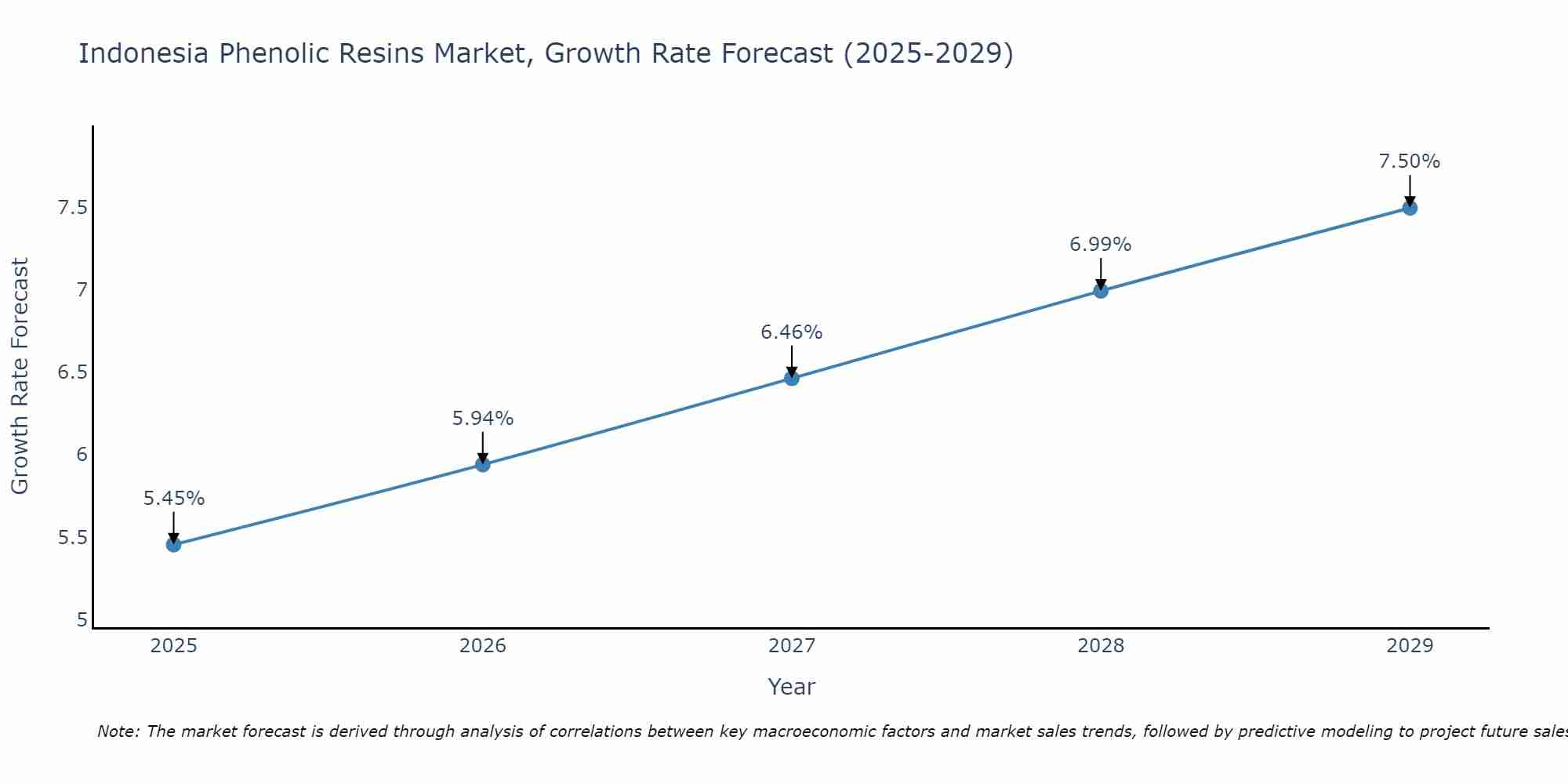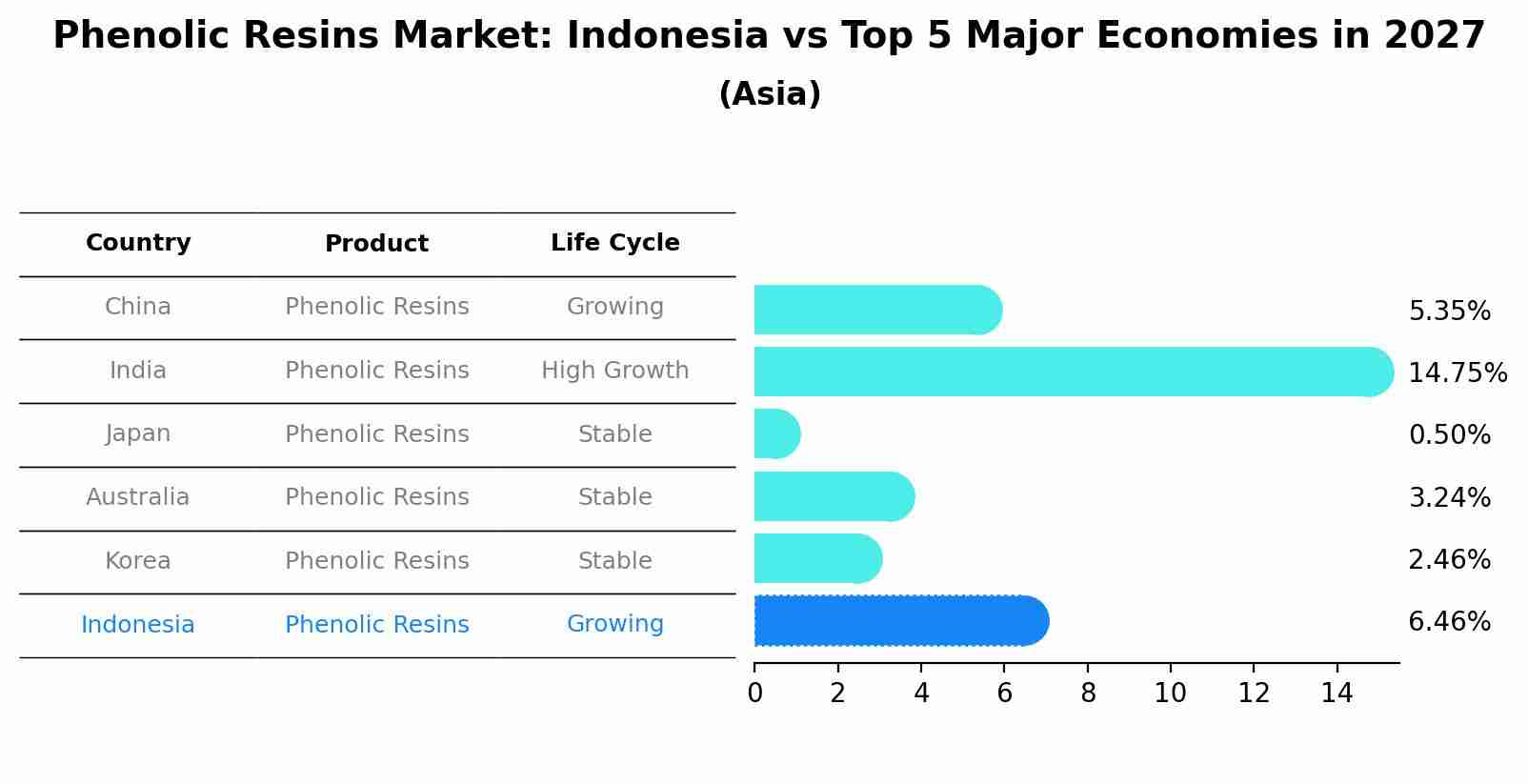Indonesia Phenolic Resins Market (2025-2031) Outlook | Revenue, Forecast, Size, Growth, Share, Analysis, Trends, Industry, Companies & Value
| Product Code: ETC081827 | Publication Date: Jul 2023 | Updated Date: Aug 2025 | Product Type: Report | |
| Publisher: 6Wresearch | No. of Pages: 70 | No. of Figures: 35 | No. of Tables: 5 | |
Indonesia Phenolic Resins Market Size Growth Rate
The Indonesia Phenolic Resins Market is likely to experience consistent growth rate gains over the period 2025 to 2029. Commencing at 5.45% in 2025, growth builds up to 7.50% by 2029.

Phenolic Resins Market: Indonesia vs Top 5 Major Economies in 2027 (Asia)
By 2027, Indonesia's Phenolic Resins market is forecasted to achieve a growing growth rate of 6.46%, with China leading the Asia region, followed by India, Japan, Australia and South Korea.

Indonesia Phenolic Resins Market Synopsis
The Indonesia phenolic resins market is slowly but steadily gaining traction in the Southeast Asia region. This growth can be attributed to several factors such as increasing demand for laminates, adhesives and other products from the furniture and construction industries. Additionally, growing environmental concerns have led to an increase in demand for bio-based polymers which are seen as a viable alternative to petrochemical derived plastics. Moreover, stringent regulations imposed by the Indonesian government on VOCs (Volatile Organic Compounds) has also been driving this market`s growth. Furthermore, increased foreign investments in various sectors within Indonesia has created new opportunities for players within this industry.
Drivers of the Market
? Rising Demand For Laminate & Adhesive Products In The Furniture & Construction Industries ? The increasing demand for laminate flooring, wall panels and adhesive products across both residential and commercial settings is driving sales of phenolic resins within these markets significantly. In addition, with more people embracing sustainable living options such as using wood-plastic composite materials instead of traditional wood or plastic materials for outdoor decking applications has further added fuel to this segment?s growth prospects over recent years.
? Growing Environmental Concerns Leading To Increase In Bio-Based Polymer Use ? Increasing awareness about climate change along with governments imposing stricter rules on emissions of air pollutants have resulted in a shift towards renewable energy sources like bio-based polymers made from vegetable oils or animal fats instead of petrochemicals extracted through fossil fuels resulting into cleaner production processes within the manufacturing sector . This shift towards ecofriendly products is expected propel revenue generation potential during the forecast period.
Challenges of the Market
? Low Cost Of Substitute Materials Such As PVC And ABS Could Hamper Growth Prospects - The availability of low cost substitutes such as PVC (Polyvinyl Chloride) and ABS (Acrylonitrile Butadiene Styrene), coupled with their superior properties make them attractive alternatives when compared against phenol based resin sourced material leading to reduced sales volume threatening overall market progress during 2025?2031 timeline
Opportunities of the Market
? Expansion Of Automotive Sector Will Offer Significant Growth Potential - With rising disposable incomes among citizens coupled with improved road infrastructure development projects being undertaken by national authorities will result into higher automotive vehicle ownership thus opening up avenues worth exploring while expanding product portfolios offered
Key Highlights of the Report:
- Indonesia Phenolic Resins Market Outlook
- Market Size of Indonesia Phenolic Resins Market, 2024
- Forecast of Indonesia Phenolic Resins Market, 2031
- Historical Data and Forecast of Indonesia Phenolic Resins Revenues & Volume for the Period 2021-2031
- Indonesia Phenolic Resins Market Trend Evolution
- Indonesia Phenolic Resins Market Drivers and Challenges
- Indonesia Phenolic Resins Price Trends
- Indonesia Phenolic Resins Porter's Five Forces
- Indonesia Phenolic Resins Industry Life Cycle
- Historical Data and Forecast of Indonesia Phenolic Resins Market Revenues & Volume By Product for the Period 2021-2031
- Historical Data and Forecast of Indonesia Phenolic Resins Market Revenues & Volume By Novolac for the Period 2021-2031
- Historical Data and Forecast of Indonesia Phenolic Resins Market Revenues & Volume By Resol for the Period 2021-2031
- Historical Data and Forecast of Indonesia Phenolic Resins Market Revenues & Volume By Others for the Period 2021-2031
- Historical Data and Forecast of Indonesia Phenolic Resins Market Revenues & Volume By Application for the Period 2021-2031
- Historical Data and Forecast of Indonesia Phenolic Resins Market Revenues & Volume By Wood Adhesives for the Period 2021-2031
- Historical Data and Forecast of Indonesia Phenolic Resins Market Revenues & Volume By Molding for the Period 2021-2031
- Historical Data and Forecast of Indonesia Phenolic Resins Market Revenues & Volume By Insulation for the Period 2021-2031
- Historical Data and Forecast of Indonesia Phenolic Resins Market Revenues & Volume By Laminates for the Period 2021-2031
- Historical Data and Forecast of Indonesia Phenolic Resins Market Revenues & Volume By Paper Impregnation for the Period 2021-2031
- Historical Data and Forecast of Indonesia Phenolic Resins Market Revenues & Volume By Coatings for the Period 2021-2031
- Historical Data and Forecast of Indonesia Phenolic Resins Market Revenues & Volume By Others for the Period 2021-2031
- Indonesia Phenolic Resins Import Export Trade Statistics
- Market Opportunity Assessment By Product
- Market Opportunity Assessment By Application
- Indonesia Phenolic Resins Top Companies Market Share
- Indonesia Phenolic Resins Competitive Benchmarking By Technical and Operational Parameters
- Indonesia Phenolic Resins Company Profiles
- Indonesia Phenolic Resins Key Strategic Recommendations
Frequently Asked Questions About the Market Study (FAQs):
1 Executive Summary |
2 Introduction |
2.1 Key Highlights of the Report |
2.2 Report Description |
2.3 Market Scope & Segmentation |
2.4 Research Methodology |
2.5 Assumptions |
3 Indonesia Phenolic Resins Market Overview |
3.1 Indonesia Country Macro Economic Indicators |
3.2 Indonesia Phenolic Resins Market Revenues & Volume, 2021 & 2031F |
3.3 Indonesia Phenolic Resins Market - Industry Life Cycle |
3.4 Indonesia Phenolic Resins Market - Porter's Five Forces |
3.5 Indonesia Phenolic Resins Market Revenues & Volume Share, By Product, 2021 & 2031F |
3.6 Indonesia Phenolic Resins Market Revenues & Volume Share, By Application, 2021 & 2031F |
4 Indonesia Phenolic Resins Market Dynamics |
4.1 Impact Analysis |
4.2 Market Drivers |
4.2.1 Increasing demand for phenolic resins in industries such as automotive, construction, and electronics. |
4.2.2 Growing focus on sustainable and eco-friendly materials, with phenolic resins being preferred for their low emissions and recyclability. |
4.2.3 Government initiatives and regulations promoting the use of phenolic resins in various applications. |
4.3 Market Restraints |
4.3.1 Fluctuating raw material prices, particularly for key inputs like phenol and formaldehyde. |
4.3.2 Intense competition from alternative materials like epoxy resins and polyurethanes. |
4.3.3 Impact of economic downturns or global trade uncertainties on the overall demand for phenolic resins. |
5 Indonesia Phenolic Resins Market Trends |
6 Indonesia Phenolic Resins Market, By Types |
6.1 Indonesia Phenolic Resins Market, By Product |
6.1.1 Overview and Analysis |
6.1.2 Indonesia Phenolic Resins Market Revenues & Volume, By Product, 2021-2031F |
6.1.3 Indonesia Phenolic Resins Market Revenues & Volume, By Novolac, 2021-2031F |
6.1.4 Indonesia Phenolic Resins Market Revenues & Volume, By Resol, 2021-2031F |
6.1.5 Indonesia Phenolic Resins Market Revenues & Volume, By Others, 2021-2031F |
6.2 Indonesia Phenolic Resins Market, By Application |
6.2.1 Overview and Analysis |
6.2.2 Indonesia Phenolic Resins Market Revenues & Volume, By Wood Adhesives, 2021-2031F |
6.2.3 Indonesia Phenolic Resins Market Revenues & Volume, By Molding, 2021-2031F |
6.2.4 Indonesia Phenolic Resins Market Revenues & Volume, By Insulation, 2021-2031F |
6.2.5 Indonesia Phenolic Resins Market Revenues & Volume, By Laminates, 2021-2031F |
6.2.6 Indonesia Phenolic Resins Market Revenues & Volume, By Paper Impregnation, 2021-2031F |
6.2.7 Indonesia Phenolic Resins Market Revenues & Volume, By Coatings, 2021-2031F |
7 Indonesia Phenolic Resins Market Import-Export Trade Statistics |
7.1 Indonesia Phenolic Resins Market Export to Major Countries |
7.2 Indonesia Phenolic Resins Market Imports from Major Countries |
8 Indonesia Phenolic Resins Market Key Performance Indicators |
8.1 Environmental certifications obtained by manufacturers, indicating compliance with sustainability standards. |
8.2 Number of research and development projects focused on enhancing the properties and applications of phenolic resins. |
8.3 Adoption rate of phenolic resins in emerging industries or niche applications, reflecting market penetration and potential for growth. |
9 Indonesia Phenolic Resins Market - Opportunity Assessment |
9.1 Indonesia Phenolic Resins Market Opportunity Assessment, By Product, 2021 & 2031F |
9.2 Indonesia Phenolic Resins Market Opportunity Assessment, By Application, 2021 & 2031F |
10 Indonesia Phenolic Resins Market - Competitive Landscape |
10.1 Indonesia Phenolic Resins Market Revenue Share, By Companies, 2024 |
10.2 Indonesia Phenolic Resins Market Competitive Benchmarking, By Operating and Technical Parameters |
11 Company Profiles |
12 Recommendations |
13 Disclaimer |
- Single User License$ 1,995
- Department License$ 2,400
- Site License$ 3,120
- Global License$ 3,795
Search
Related Reports
- ASEAN Bearings Market (2025-2031) | Strategy, Consumer Insights, Analysis, Investment Trends, Opportunities, Growth, Size, Share, Industry, Revenue, Segments, Value, Segmentation, Supply, Forecast, Restraints, Outlook, Competition, Drivers, Trends, Demand, Pricing Analysis, Competitive, Strategic Insights, Companies, Challenges
- Europe Flooring Market (2025-2031) | Outlook, Share, Industry, Trends, Forecast, Companies, Revenue, Size, Analysis, Growth & Value
- Saudi Arabia Manlift Market (2025-2031) | Outlook, Size, Growth, Trends, Companies, Industry, Revenue, Value, Share, Forecast & Analysis
- Uganda Excavator, Crane, and Wheel Loaders Market (2025-2031) | Strategy, Consumer Insights, Analysis, Investment Trends, Opportunities, Growth, Size, Share, Industry, Revenue, Segments, Value, Segmentation, Supply, Forecast, Restraints, Outlook, Competition, Drivers, Trends, Demand, Pricing Analysis, Competitive, Strategic Insights, Companies, Challenges
- Rwanda Excavator, Crane, and Wheel Loaders Market (2025-2031) | Strategy, Consumer Insights, Analysis, Investment Trends, Opportunities, Growth, Size, Share, Industry, Revenue, Segments, Value, Segmentation, Supply, Forecast, Restraints, Outlook, Competition, Drivers, Trends, Demand, Pricing Analysis, Competitive, Strategic Insights, Companies, Challenges
- Kenya Excavator, Crane, and Wheel Loaders Market (2025-2031) | Strategy, Consumer Insights, Analysis, Investment Trends, Opportunities, Growth, Size, Share, Industry, Revenue, Segments, Value, Segmentation, Supply, Forecast, Restraints, Outlook, Competition, Drivers, Trends, Demand, Pricing Analysis, Competitive, Strategic Insights, Companies, Challenges
- Angola Excavator, Crane, and Wheel Loaders Market (2025-2031) | Strategy, Consumer Insights, Analysis, Investment Trends, Opportunities, Growth, Size, Share, Industry, Revenue, Segments, Value, Segmentation, Supply, Forecast, Restraints, Outlook, Competition, Drivers, Trends, Demand, Pricing Analysis, Competitive, Strategic Insights, Companies, Challenges
- Israel Intelligent Transport System Market (2025-2031) | Strategy, Consumer Insights, Analysis, Investment Trends, Opportunities, Growth, Size, Share, Industry, Revenue, Segments, Value, Segmentation, Supply, Forecast, Restraints, Outlook, Competition, Drivers, Trends, Demand, Pricing Analysis, Competitive, Strategic Insights, Companies, Challenges
- Uganda Precast and Aggregate Market (2025-2031) | Strategy, Consumer Insights, Analysis, Investment Trends, Opportunities, Growth, Size, Share, Industry, Revenue, Segments, Value, Segmentation, Supply, Forecast, Restraints, Outlook, Competition, Drivers, Trends, Demand, Pricing Analysis, Competitive, Strategic Insights, Companies, Challenges
- Australia IT Asset Disposal Market (2025-2031) | Strategy, Consumer Insights, Analysis, Investment Trends, Opportunities, Growth, Size, Share, Industry, Revenue, Segments, Value, Segmentation, Supply, Forecast, Restraints, Outlook, Competition, Drivers, Trends, Demand, Pricing Analysis, Competitive, Strategic Insights, Companies, Challenges
Industry Events and Analyst Meet
Our Clients
Whitepaper
- Middle East & Africa Commercial Security Market Click here to view more.
- Middle East & Africa Fire Safety Systems & Equipment Market Click here to view more.
- GCC Drone Market Click here to view more.
- Middle East Lighting Fixture Market Click here to view more.
- GCC Physical & Perimeter Security Market Click here to view more.
6WResearch In News
- Doha a strategic location for EV manufacturing hub: IPA Qatar
- Demand for luxury TVs surging in the GCC, says Samsung
- Empowering Growth: The Thriving Journey of Bangladesh’s Cable Industry
- Demand for luxury TVs surging in the GCC, says Samsung
- Video call with a traditional healer? Once unthinkable, it’s now common in South Africa
- Intelligent Buildings To Smooth GCC’s Path To Net Zero













